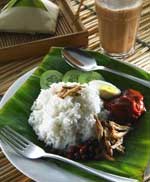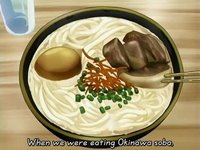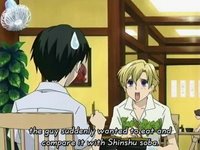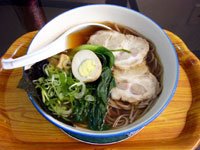Food-spotting v. 2
On Ouran 24, during one of Tamaki and Kyouya's little regional ventures, it seems that Tamaki wanted to eat Okinawan soba, and later compare it to Shinshu soba. It not only whetted my appetite (I haven't eaten!) but also my desire to know the difference myself.
To start with, soba is a thin Japanese buckwheat noodle (the word soba itself actually means buckwheat!) which can be eaten either hot as soba in broth ("kake soba") or cold ("zaru soba"). Being made out of buckwheat is apparently unusual and quite a feat since noodles made out of buckwheat tend to fall apart easily. Soba is commonly eaten with chopsticks and it is traditionally considered polite to slurp the noodles noisily. I think this has to do with the diner's appreciation for his/her food as a mark of respect to those who served it to him/her. Slurping hot noodles also helps to cool them down. Soba is apparently the noodle of choice when it comes to Tokyo residents! Apparently, this originates from the Edo era where consuming primarily white rice, which had low levels of thiamine, led to beri beri. So came thiamine-rich soba!=D Ingenious ;) Occasionally, soba is used to refer to noodles in general. In Japan, ramen is sometimes called chuka soba or shina soba (meaning Chinese noodles) and doesn't contain buckwheat. Stir-fried chuka soba is famously called yakisoba.
To start with, soba is a thin Japanese buckwheat noodle (the word soba itself actually means buckwheat!) which can be eaten either hot as soba in broth ("kake soba") or cold ("zaru soba"). Being made out of buckwheat is apparently unusual and quite a feat since noodles made out of buckwheat tend to fall apart easily. Soba is commonly eaten with chopsticks and it is traditionally considered polite to slurp the noodles noisily. I think this has to do with the diner's appreciation for his/her food as a mark of respect to those who served it to him/her. Slurping hot noodles also helps to cool them down. Soba is apparently the noodle of choice when it comes to Tokyo residents! Apparently, this originates from the Edo era where consuming primarily white rice, which had low levels of thiamine, led to beri beri. So came thiamine-rich soba!=D Ingenious ;) Occasionally, soba is used to refer to noodles in general. In Japan, ramen is sometimes called chuka soba or shina soba (meaning Chinese noodles) and doesn't contain buckwheat. Stir-fried chuka soba is famously called yakisoba.
Okinawan soba is what soba is referred to in Okinawa, and is a misnomer as these noodles are made out of flour rather than buckwheat, and more similar to udon. The broth is derived from pork bones and bonito shavings. Toppings include leek, sliced pork, boiled fish paste, short ribs and vegetables. I read on a site that soba is to Okinawa what hot dogs are to Americans, and I suppose this demonstrates the ubiquitious-ness that is soba in Okinawa. It is apparently quite popular across the globe in Campo Grande, Brazil as well! This is due to the influx of Okinawan immigrants and soba is sold at street markets or served at "sobarias", special soba restaurants.
The most famous soba noodles come from Nagano in Japan and these are named by either location or ingredients. Shinshu soba is named after the southern region of Nagano. These noodles are made out of buckwheat.
I guess the different constituents and the fact that 'soba' is famous in both regions is why Tamaki wanted to compare the two!
I guess the different constituents and the fact that 'soba' is famous in both regions is why Tamaki wanted to compare the two!
 On another note, I was reading brudirect the other day and I noticed that the government had launched 'Operation Knock Rice' to ensure the hygiene in preparation of 'Knock Rice' or 'Nasi Katok'. Lol somehow I feel that Knock Rice is too literal a translation. Then again, what else could they call it right? 'Knock for rice' which is more suitable since 'Nasi Katok' was derived by customers knocking on the vendor's door anytime throughout the 24 hours in a day for the dish? Somehow, it doesn't sound so good rolling off the tongue... 'Knock-knock rice'?? Catchier but less reflective of the meaning. Looks like "Nasi Katok" is still the reigning label in my book!;)
On another note, I was reading brudirect the other day and I noticed that the government had launched 'Operation Knock Rice' to ensure the hygiene in preparation of 'Knock Rice' or 'Nasi Katok'. Lol somehow I feel that Knock Rice is too literal a translation. Then again, what else could they call it right? 'Knock for rice' which is more suitable since 'Nasi Katok' was derived by customers knocking on the vendor's door anytime throughout the 24 hours in a day for the dish? Somehow, it doesn't sound so good rolling off the tongue... 'Knock-knock rice'?? Catchier but less reflective of the meaning. Looks like "Nasi Katok" is still the reigning label in my book!;)(in the pic: rice usually made with coconut milk, half a hardboiled egg, chicken, sambal, roasted (?) peanuts, dried fish on top of the rice, cucumbers on the side. All on a pandan leaf. The best, IMO, has minimal onions lol but that's just my preference. Note teh tarik as the drink of choice here.)






0 Comments:
Post a Comment